Docedyth
On this page, you find all documents, package deals, and flashcards offered by seller DocEdyth.
- 518
- 0
- 22
Community
- Followers
- Following
540 items
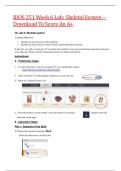
BIOS 251 Week 6 Lab: Skeletal System – Download To Score An A+
BIOS 251 Week 6 Lab: Skeletal System – Download To Score An A+ OL Lab 6: Skeletal system Learning Objectives: • Identify the two divisions of the skeleton. • Identify the bony features found on bones and identify their functions In this lab, you will use Anatomy TV to explore the skeletal system and correlate the anatomical structures to its functions. Please read the instructions before you begin with the lab. Instructions: A. Preliminary steps: 1. Use the link below to log in...
- Other
- • 23 pages •
BIOS 251 Week 6 Lab: Skeletal System – Download To Score An A+ OL Lab 6: Skeletal system Learning Objectives: • Identify the two divisions of the skeleton. • Identify the bony features found on bones and identify their functions In this lab, you will use Anatomy TV to explore the skeletal system and correlate the anatomical structures to its functions. Please read the instructions before you begin with the lab. Instructions: A. Preliminary steps: 1. Use the link below to log in...
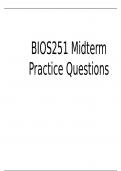
BIOS251 Midterm Practice Questions – Graded An A+
BIOS251 Midterm Practice Questions – Graded An A+ Structures of the body that can be examined without a microscope is known as what? a. Cell biology b. Systemic anatomy c. Gross anatomy d. Surface anatomy a. Cell biology b. Systemic anatomy c. Gross anatomy d. Surface anatomy Which of the following are life processes in humans? Select all that apply a. Metabolism b. Growth c. Reproduction d. Healing ...
- Other
- • 35 pages •
BIOS251 Midterm Practice Questions – Graded An A+ Structures of the body that can be examined without a microscope is known as what? a. Cell biology b. Systemic anatomy c. Gross anatomy d. Surface anatomy a. Cell biology b. Systemic anatomy c. Gross anatomy d. Surface anatomy Which of the following are life processes in humans? Select all that apply a. Metabolism b. Growth c. Reproduction d. Healing ...

BIOS 251 Week 4 Discussion: Histology and Tissue Types – Graded An A+
BIOS 251 Week 4 Discussion: Histology and Tissue Types – Graded An A+ Question: • Classify the major exocrine glands with respect to their structure, their modes of secretion, and give clear examples of where each class of gland would be found in the human body. Answer: A gland is a functional unit of cells that work together to create and secrete these substances. Exocrine glands are comprised of an acinus and a duct with different cell types, respectively and secrete substances in...
- Other
- • 6 pages •
BIOS 251 Week 4 Discussion: Histology and Tissue Types – Graded An A+ Question: • Classify the major exocrine glands with respect to their structure, their modes of secretion, and give clear examples of where each class of gland would be found in the human body. Answer: A gland is a functional unit of cells that work together to create and secrete these substances. Exocrine glands are comprised of an acinus and a duct with different cell types, respectively and secrete substances in...
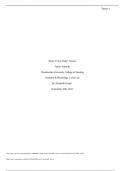
BIOS 251 Week 4 Case Study: Tissue – Graded An A+
BIOS 251 Week 4 Case Study: Tissue – Graded An A+ Describe the five different layers of the skin. The five layers of the skin are known as the epidermis, which is divided further into five different layers. The layers are stratum corneum, stratum lucidum, spinosum, granulosum, and stratum basale. All five of these layers contain different characteristics and responsibilities for the skin. - Stratum corneum is the most superficial layer and is the one that is visible, so ...
- Case
- • 5 pages •
BIOS 251 Week 4 Case Study: Tissue – Graded An A+ Describe the five different layers of the skin. The five layers of the skin are known as the epidermis, which is divided further into five different layers. The layers are stratum corneum, stratum lucidum, spinosum, granulosum, and stratum basale. All five of these layers contain different characteristics and responsibilities for the skin. - Stratum corneum is the most superficial layer and is the one that is visible, so ...
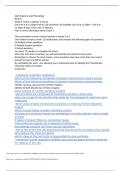
BIOS 251 Week 3, Week 4 Cells-Tissues Review Question – Exam 2 – Graded An A+
BIOS 251 Week 3, Week 4 Cells-Tissues Review Question – Exam 2 – Graded An A+ 3 products of aerobic respiration which of the following membrane transport mechanisms require energy which of the following membrane transport mechanisms require energy Identify cardiac muscle (out of these images) Identify Smooth Muscle (out of these images) which portion of ...
- Other
- • 2 pages •
BIOS 251 Week 3, Week 4 Cells-Tissues Review Question – Exam 2 – Graded An A+ 3 products of aerobic respiration which of the following membrane transport mechanisms require energy which of the following membrane transport mechanisms require energy Identify cardiac muscle (out of these images) Identify Smooth Muscle (out of these images) which portion of ...

BIOS 251 Week 3 Case Study Cells – Graded An A+
BIOS 251 Week 3 Case Study Cells – Graded An A+ Week 3 Case Study: The Cell 1. Brian indicates that the mutation is in a gene found in the mitochondrial DNA. What does Brian mean by that and why did he signify mitochondrial DNA? There is a certain type of DNA inside the mitochondria. This DNA is somewhat different to the DNA found in the nucleus, is small and circular and comprises 37 genes. Mitochondrial DNA encodes different proteins that are specific for the mitochondri...
- Case
- • 3 pages •
BIOS 251 Week 3 Case Study Cells – Graded An A+ Week 3 Case Study: The Cell 1. Brian indicates that the mutation is in a gene found in the mitochondrial DNA. What does Brian mean by that and why did he signify mitochondrial DNA? There is a certain type of DNA inside the mitochondria. This DNA is somewhat different to the DNA found in the nucleus, is small and circular and comprises 37 genes. Mitochondrial DNA encodes different proteins that are specific for the mitochondri...
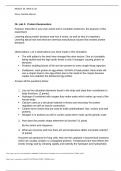
BIOS 251 Week 2 Lab: Protein Denaturation – Download To Score An A+
BIOS 251 Week 2 Lab: Protein Denaturation – Download To Score An A+ OL Lab 2: Protein Denaturation Purpose: Describe in your own words and in complete sentences, the purpose of this experiment. Learning about protein denature and how it works, as well as why it’s important. Learning about how and what are chemical and physical causes that creates protein denature. Observations: List 3 observations you have made in this simulation. • The milk added to the beef stew changed the ...
- Other
- • 2 pages •
BIOS 251 Week 2 Lab: Protein Denaturation – Download To Score An A+ OL Lab 2: Protein Denaturation Purpose: Describe in your own words and in complete sentences, the purpose of this experiment. Learning about protein denature and how it works, as well as why it’s important. Learning about how and what are chemical and physical causes that creates protein denature. Observations: List 3 observations you have made in this simulation. • The milk added to the beef stew changed the ...

BIOS-251 Week 2 Case Study: Chemistry – Download To Score An A+
Running Page: Week 2 Case Study: Chemistry BIOS-251 Week 2 Case Study: Chemistry – Download To Score An A+ Despite numerous differences in terms of the structure, composition as well as their functions, carbohydrates and fats are chemically related. First, both fats and carbohydrates are organic compounds. This means that both contain the elements of carbon (C), hydrogen (H), and oxygen (O) (Kuhnt et al., 2011). As such, carbohydrates and fats are related from the fact that both are or...
- Case
- • 4 pages •
Running Page: Week 2 Case Study: Chemistry BIOS-251 Week 2 Case Study: Chemistry – Download To Score An A+ Despite numerous differences in terms of the structure, composition as well as their functions, carbohydrates and fats are chemically related. First, both fats and carbohydrates are organic compounds. This means that both contain the elements of carbon (C), hydrogen (H), and oxygen (O) (Kuhnt et al., 2011). As such, carbohydrates and fats are related from the fact that both are or...

BIOS 251 WEEK I DISCUSSION; HOMEOSTASIS – WITH 100% CORRECT ANSWERS
BIOS 251 WEEK I DISCUSSION; HOMEOSTASIS – WITH 100% CORRECT ANSWERS BIOS 251 Week 1 Discussion ● What does the term homeostasis mean? ● What types of mechanisms are used by the body to maintain homeostasis? ● Give an example of the mechanisms. ● What happens when homeostasis can not be restored? Answer: This week is the discussion on all things homeostasis. In the book Anatomy & Physiology: The Unity of Form and Functio...
- Other
- • 2 pages •
BIOS 251 WEEK I DISCUSSION; HOMEOSTASIS – WITH 100% CORRECT ANSWERS BIOS 251 Week 1 Discussion ● What does the term homeostasis mean? ● What types of mechanisms are used by the body to maintain homeostasis? ● Give an example of the mechanisms. ● What happens when homeostasis can not be restored? Answer: This week is the discussion on all things homeostasis. In the book Anatomy & Physiology: The Unity of Form and Functio...
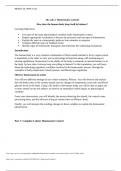
BIOS 251 Week 1: Master Homeostatic Control – Download now and secure that A+!
BIOS 251 Week 1: Master Homeostatic Control – Download now and secure that A+! Learning Objectives: OL Lab 1: Homeostatic Control How does the human body keep itself in balance? • List some of the main physiological variables under homeostatic control • Employ appropriate vocabulary to discuss the processes and concepts of homeostasis • Explain the steps in a homeostatic pathway from stimulus to response • Compare different types of feedback loops • Identify ...
- Other
- • 5 pages •
BIOS 251 Week 1: Master Homeostatic Control – Download now and secure that A+! Learning Objectives: OL Lab 1: Homeostatic Control How does the human body keep itself in balance? • List some of the main physiological variables under homeostatic control • Employ appropriate vocabulary to discuss the processes and concepts of homeostasis • Explain the steps in a homeostatic pathway from stimulus to response • Compare different types of feedback loops • Identify ...
